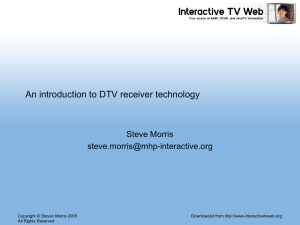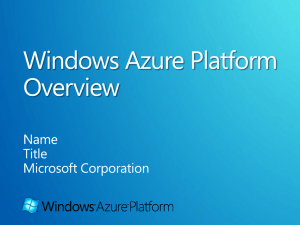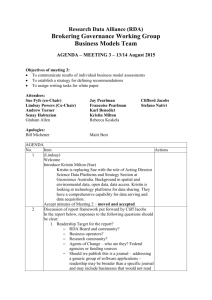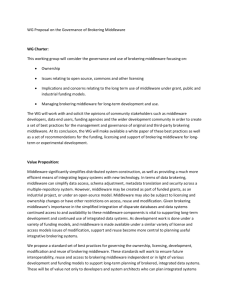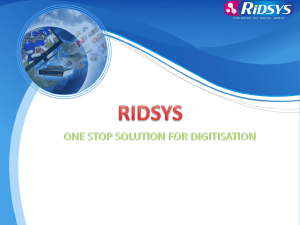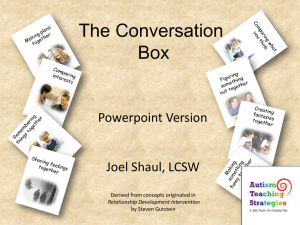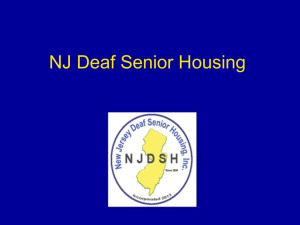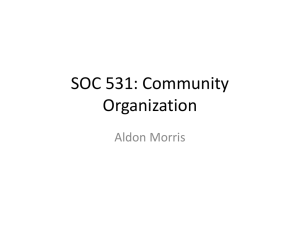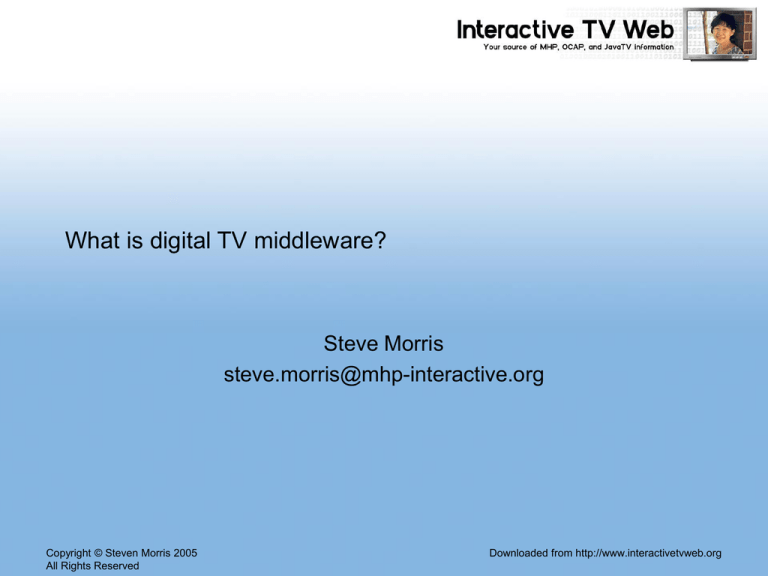
What is digital TV middleware?
Steve Morris
steve.morris@mhp-interactive.org
Copyright © Steven Morris 2005
All Rights Reserved
Downloaded from http://www.interactivetvweb.org
What is middleware?
• Middleware is a software layer that sites on top of (or instead of) the
OS in an STB
• It allows a content developers to work without having to consider
low-level issues for an STB
– Drivers, Operating System, etc.
• This makes it easier to write complex applications
Copyright © Steven Morris 2005
All Rights Reserved
Downloaded from http://www.interactivetvweb.org
What is middleware?
• Middleware runs between the device drovers/OS and the
application
• Literally ‘in the middle’ of the software stack
Application
Application
Application
Application
Middleware
RTOS
CA System
Device drivers
STB hardware
Copyright © Steven Morris 2005
All Rights Reserved
Downloaded from http://www.interactivetvweb.org
Why use middleware?
• Makes it easier to write complex applications
• Allows portability across hardware and operating systems
– Applications will run on any platform the middleware has been ported to
– The application developer doesn’t need to consider the OS/hardware in every
STB the application will run on
• Makes it easier for third parties to write applications
– Only need to learn about a few middleware platforms
– More abstraction makes learning easier
Copyright © Steven Morris 2005
All Rights Reserved
Downloaded from http://www.interactivetvweb.org
Types of middleware
• Proprietary middleware
– Designed by a single company
– Licensed to STB manufacturers
– Most common in pay TV
• Open middleware
–
–
–
–
Standardised by an industry body
Can be implemented by anyone
Licensing fee is usually small
More commonly used in free TV
• e.g. MHEG in UK terrestrial market
Copyright © Steven Morris 2005
All Rights Reserved
Downloaded from http://www.interactivetvweb.org
Proprietary middleware examples
•
OpenTV Core (OpenTV)
–
–
•
•
•
•
•
the Microsoft of iTV middleware
70% market share
MediaHighway (Canal+)
Microsoft TV (Microsoft)
Liberate
PowerTV
NDS Core (NDS)
Copyright © Steven Morris 2005
All Rights Reserved
Downloaded from http://www.interactivetvweb.org
Open middleware examples
•
•
MHEG
DAVIC
–
•
MHP
–
–
–
•
Open standard for US cable market
Based on MHP
ACAP
–
•
•
Open middleware standard from DVB
Broad industry support
Used as basis for other standards
OCAP
–
–
•
MHEG + Java
ATSC’s middleware based on MHP
ARIB B23
JavaTV
Copyright © Steven Morris 2005
All Rights Reserved
Downloaded from http://www.interactivetvweb.org
So what does it do?
• All middleware offers the same basic features
• Hides the hardware/OS layer from an application and provides a set
of commonly used functions
– Abstracts over complex hardware and software functions
– Provides a more natural environment for developers
– Allows the use of pre-built components
• E.g web browsers, graphics support
– Offers better software tools
• E.g. more choice of programming language
Copyright © Steven Morris 2005
All Rights Reserved
Downloaded from http://www.interactivetvweb.org
Services the middleware offers
• An application model
• MPEG decoder/demux access
• Graphics display
– Access to multiple video planes
– Access to graphics/video integration features
• Service information access
• User input (via RCU or keyboard)
– Supports a standard input model and key codes
• Access to the return channel (TCP/IP)
– Modem or broadband
• Memory management
Copyright © Steven Morris 2005
All Rights Reserved
Downloaded from http://www.interactivetvweb.org
Services the middleware offers
• Software development environment
– Usually C/C++ or Java
– Sometimes other languages
• Possibly proprietary scripting languages
– HTML may be supported
• More complex features
– Internationalisation
– Web browsing & internet access
• May be offered as a core part of the middleware or as an additional
option
– To reduce cost and space
Copyright © Steven Morris 2005
All Rights Reserved
Downloaded from http://www.interactivetvweb.org
Problems with closed middleware
• Too many different middleware vendors
–
–
–
–
Different markets use different middleware
Content must be developed repeatedly for different customers
Content can’t be re-sold
This limits the total size of the market
• Licensing costs are quite high
– ~US$10 per box for OpenTV, for example
– This increases STB costs
Copyright © Steven Morris 2005
All Rights Reserved
Downloaded from http://www.interactivetvweb.org
The next challenges
• How do we grow the market?
– This is why open standards are so popular
• STBs can be treated more like VCRs
• Transition from vertical to horizontal markets
– Allows current big players a smaller piece of a much larger market
• Getting true interactivity
– We don’t have this yet
– Requires advanced features
• Not popular in a bad economic environment
– Too expensive and no proven business model
• But we are making progress, e.g. BSkyB in the UK
Copyright © Steven Morris 2005
All Rights Reserved
Downloaded from http://www.interactivetvweb.org
Will open middleware really take off?
• No-one knows yet
• Many companies support it
– Including some proprietary middleware vendors
– See it as a chance to grow the overall market
• Allows the entire industry to change its business model
– From vertical to horizontal markets
– Sell STBs through retail outlets
• Less exposure for network operators
– Allow customers more choice
• Move from one operator to another without replacing your STB
• Add more features to an STB, e.g. PVR, games console, broadband gateway
Copyright © Steven Morris 2005
All Rights Reserved
Downloaded from http://www.interactivetvweb.org
Questions?
• For more information:
– http://www.mhp.org
– http://www.interactivetvweb.org
– “Interactive TV standards”, S. Morris & A. Smith-Chaigneau
(Pub. Focal Press, ISBN 0240806662 )
Copyright
Steven
Copyright
© Steven©
Morris
2002.Morris
All
All Rights Reserved
rights reserved.
2005
Downloaded from http://www.interactivetvweb.org

